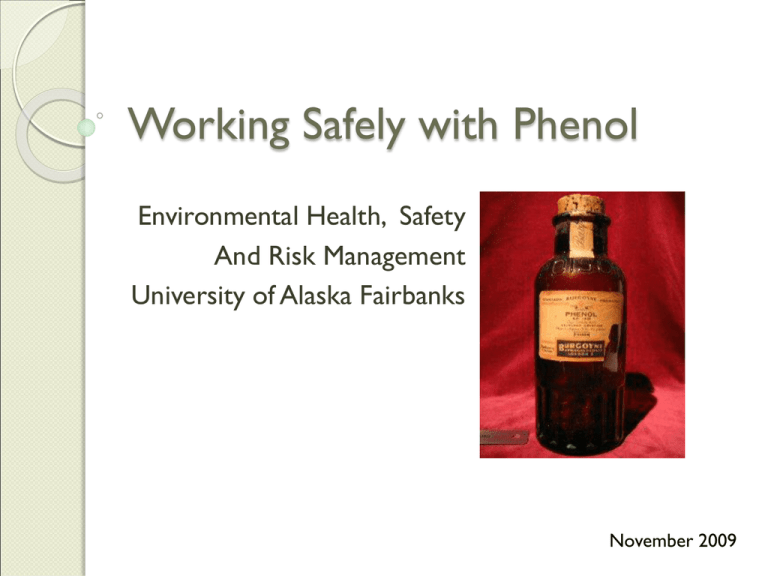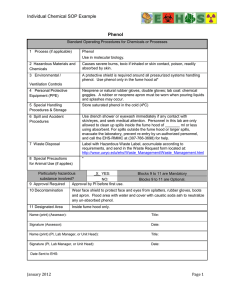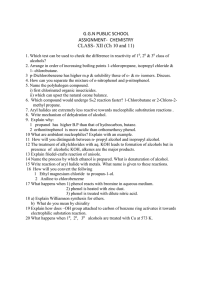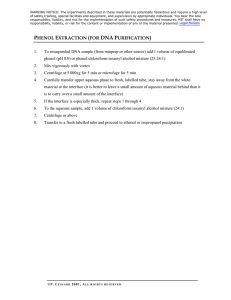Working Safely with Phenol Environmental Health, Safety And Risk Management
advertisement

Working Safely with Phenol Environmental Health, Safety And Risk Management University of Alaska Fairbanks November 2009 Overview Properties of Phenol Routes of Exposure and Health Effects Protecting Yourself Handling and Storage Spills and Exposure Waste Disposal Phenol Spill/Exposure Kit 2 Properties of Phenol At room temperature, phenol is a translucent, colorless, crystalline mass, a white powder, or a thick, syrupy liquid The crystals are hygroscopic and turn pink to red in air When pure, phenol has a sweet, tar-like odor that is readily detected at low concentrations (0.05 ppm in air) Phenol is soluble in alcohol, glycerol, petroleum, and, to a lesser extent, water 3 Properties of Phenol (cont.): Exposure Limits OSHA permissible exposure limit (PEL) is 5 ppm (8-hour shift). Includes a "Skin" notation, which indicates that the cutaneous route of exposure (including mucous membranes and eyes) contributes to overall exposure. NIOSH has established a short-term exposure limit (STEL) of 15.6 ppm (not to exceed 15 minutes), and includes “Skin” notation. NIOSH IDLH (immediately dangerous to life or health) = 250 ppm 4 Routes of Exposure Phenol: ◦ is poisonous, corrosive, and flammable. ◦ affects the central nervous system and targets the liver and kidneys. ◦ is mutagenic and possibly teratogenic. Routes of exposure include: ◦ ◦ ◦ ◦ ◦ Inhalation Absorption Ingestion Eyes Use of products containing phenol 5 Routes of Exposure: Inhalation Phenol is absorbed rapidly from the lungs into the bloodstream. ◦ However, because of its low volatility, the inhalation hazard is limited. The odor threshold of phenol is about 100 times lower than the OSHA PEL. ◦ There is adequate warning when hazardous concentrations exist. Breathing vapor, dust or mist results in digestive disturbances (vomiting, difficulty in swallowing, diarrhea, loss of appetite). Causes irritation and possible burns to respiratory tract 6 Routes of Exposure: Absorption All forms of phenol cause irritation, and acute toxic effects of phenol most often occur by skin contact. Even dilute solutions (1 to 2%) may cause severe burns if contact is prolonged. Due to its local anesthetizing properties, skin burns may be painless. Phenol vapor and liquid penetrate the skin readily. Absorption of phenol by the skin is enhanced when chloroform is also present (chloroform is volatile, phenol is not). 7 Routes of Exposure: Absorption (cont.) Systemic poisoning effects follow skin absorption. Discoloration and severe burns may occur, but may be disguised by a loss of pain sensation. 8 Routes of Exposure: Ingestion As little as 1 gram has been lethal to humans. Symptoms may include burning pain in mouth and throat, abdominal pain, nausea, vomiting, headache, dizziness, muscular weakness, central nervous system effects, increase in heart rate, irregular breathing, coma, and possibly death. 9 Routes of Exposure: Eyes Corrosive to eyes ◦ Eye burns with redness, pain, blurred vision may occur May cause severe damage and blindness 10 Routes of Exposure: Products Containing Phenol Phenol, in low doses, can be found in some consumer products. It is used as a disinfectant, antiseptic and pain reliever Mostly used in the manufacture of resins and plastics, but it is also found in explosives, fertilizers, paints rubber, textiles, adhesives, drugs, paper, soap, wood preservatives and photographic developers. 11 Protecting Yourself Engineering controls Personal protective equipment Specific lab safety practices 12 Protecting yourself: Engineering Controls Always use phenol in a properly functioning chemical fume hood Conduct all work at least 6” inside sash Keep sash as low as possible (even lower than the posted maximum operating sash height) Conduct all work in a plastic tray for spill containment 13 Protecting Yourself: Personal Protective Equipment Long pants and long-sleeve shirt with reasonably high neck (no low cut shirts) Closed-toe shoes or rubber boots Chemical resistant lab coat (NOT the standard cotton-poly ones) or chemical resistant apron Splash goggles or face shield (in addition to fume hood sash) Gloves: Neoprene, butyl rubber, or laminate barrier (Silver Shield®) ◦ for phenol-chloroform mixtures, use Viton or heavyweight (>15 mil) nitrile. ◦ DO NOT USE NITRILE OR LATEX! Additional PPE may be required, depending on the specific procedures used in your lab 14 Specific Lab Safety Practices Use caution when centrifuging phenol. Centrifugation produces aerosols enhancing exposure via inhalation. If you suspect a tube has broken or a rotor has failed, wait 10 minutes prior to opening the centrifuge and/or rotor lid. This allows aerosolized phenol to settle out. Open them in the fume hood if at all possible. ◦ After centrifuging, always open bottles or tubes in a fume hood to prevent exposure to aerosols. Never heat or melt phenol in an incubator, microwave, drying oven or similar device. Have a phenol spill/exposure kit available (List at end of training module) 15 Specific Lab Safety Practices (cont.) Review your protocol prior to beginning the procedure (every time) Inspect your PPE for cracks, holes, signs of wear Make sure the fume hood has a current maximum sash height sticker Clearly label ALL bottles (stocks and wastes) Use the smallest amount possible Make sure a copy of the MSDS is in the lab Chemical Hygiene Plan notebook Ensure unobstructed access to a functioning eye wash and safety shower 16 Storage of Phenol Keep in a tightly closed container Store in a cool, dry, ventilated area away from sources of heat or ignition Store separately from reactive chemicals, combustible materials, and bases. Keep out of direct sunlight Avoid dust formation and control ignition sources Store containers on shelves below eye level 17 Spills and Exposures Liquid spills not involving contact with a person (be sure to wear your PPE) ◦ If you do not feel comfortable cleaning up the spill, call EHS&RM for help (never put yourself at risk!) ◦ Small liquid spills of 50 ml or less may be absorbed with sand, vermiculite or other noncombustible absorbent material. Pick up (use non-sparking tools and equipment; do not use combustible materials such as corn whisks or brooms) and place in a sealed container or double plastic bags for proper disposal as hazardous waste. Do not dump down the drain or into the trash. ◦ If the spilled material is heated or is greater than 50 ml, remove ignition sources, evacuate the laboratory, close the doors, and call the Hazmat Division at 474-5617. After hours, contact Emergency Dispatch at 474-7721 or dial 911. 18 Spills and Exposures(cont.) Dry spills not involving contact with a person (be sure to wear your PPE) If you do not feel comfortable cleaning up the spill, call EHS&RM for help (never put yourself at risk!) ◦ Clean up spills in a manner that does not disperse dust into the air ◦ Reduce airborne dust and prevent scattering by moistening with water--do not flood ◦ Pick up spill (use non-sparking tools and equipment; do not use combustible materials such as corn whisks or brooms) and place in a sealed container or double plastic bags for proper disposal as hazardous waste. Do not dump down the drain or into a waste basket. 19 Spills and Exposures: Skin If assisting the victim, the responder should don PPE (gloves, goggles, lab coat) to avoid being exposed themselves. Note: If victim’s clothing is heavily soaked, off-gassing of vapors can contaminate the responder! Appropriate respiratory protection must be worn. Do not assist. Call 911 or Emergency Dispatch 474-7721. Remove contaminated clothing rapidly and begin decontamination as soon as possible Because dilution of phenol in water enhances dermal absorption of phenol, it has been recommended that polyethylene glycol, glycerol, or vegetable oil be used to remove dermal contamination with phenol ◦ Do not use mineral oil 20 Spills and Exposures: Skin (cont.) After cleaning with glycerol or oil, skin should be washed with soap and water for at least 15 minutes Move victim to fresh air if safe to do so Double bag any contaminated clothing A copy of the CDC exposure information should accompany victim to the emergency room (see Exposure Response Kit) 21 Spills and Exposures: Ingestion If swallowed, immediately administer castor oil or other vegetable oil. Castor oil (or vegetable oil) dosage should be between 15 and 30 cc Never give anything by mouth to an unconscious person A copy of the CDC exposure information should accompany victim to the emergency room (see Exposure Response Kit) 22 Spills and Exposures: Eye Immediately hold eyelids apart and flush eyes continuously with copious amounts of cool flowing water for at least 15 minutes Ensure complete irrigation of the eye by keeping eyelids apart and away from eye and moving the eyelids by occasionally lifting the upper and lower lids A copy of the CDC exposure information should accompany victim to the emergency room (in Exposure Response Kit) 23 Spills and Exposures: Inhalation Responder should immediately help victim to fresh air if it is safe to do so Call 911 and tell them you have an phenol exposure A copy of the CDC exposure information should accompany victim to the emergency room (in Exposure Response Kit) 24 Spills and Exposures If you are ALONE… ◦ Remain calm… ◦ Remove contaminated clothing ◦ Begin using polyethylene glycol, glycerol, or vegetable oil to remove dermal contamination ◦ Wash yourself in the emergency shower or sink with soap and water for 15 minutes ◦ Use eyewash for eye exposures ◦ If ingested, administer castor oil or vegetable oil ◦ Call 911 and tell them you have been exposed to phenol, and give your exact location ◦ Take a copy of the CDC exposure information to the emergency room (in Exposure Response Kit) 25 Waste Disposal Collect all phenol-containing wastes in a welllabeled, clean container or double bag ◦ No phenol wastes should ever be put down the drain or into the trash ◦ Clearly label container with the concentration and a warning statement ◦ Store wastes properly When the container is full, complete Hazardous Waste Removal Request paperwork, and call EHS&RM for removal (474-5617) 26 Phenol Spill/Exposure Kit Sand, vermiculite or other noncombustible absorbent material 2 bags or ziplocks or clean container with lid for hazardous wastes 2 bags for contaminated clothing Hazardous waste labels for bags or containers Polyethylene glycol, glycerol, or vegetable oil (not mineral oil) Copy of CDC phenol exposure information give to emergency room nurse/treating physician: Obtain here: http://www.atsdr.cdc.gov/mhmi/mmg115.pdf 27 Questions? Contact EHS&RM at 474-6771 or 474-5197. Quiz information on next slide. Thank you! Please complete the quiz Quiz is located at: www.uaf.edu/safety ◦ Training ◦ UAF Safety Training PowerPoints Complete quiz, click the “send quiz to EHS&RM” button. NOTE:There is no need to contact EHS&RM to let us know you have finished the quiz. fysafety@uaf.edu is checked throughout the day, and your score will be electronically filed for future reference. 29






